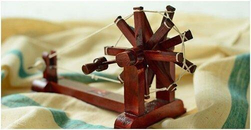Khadi

Khadi is a term used for fabrics that are handspun and handwoven, usually from cotton fiber. Khadi, also called khaddar, is a hand-woven natural fibre cloth originating from eastern regions of the Indian subcontinent, mainly Eastern India, Northeastern India and Bangladesh, but is now broadly used throughout India and Pakistan. While the fabric is often associated with the cloth usually woven from cotton, khadi can actually refer to any natural fabric (cotton, wool or silk) that has been handspun into yarn on a spinning wheel called a charkha.
The name khadi comes from the word ‘khaddar' (meaning handspun in the subcontinent), and is an example of India's ancient handmade textile traditions that go back to 400BC according to Greek historian, Herodotus. By the late 17th century, Indian fabrics were so superior that they dominated European markets, and were eventually banned by the French and British to reduce competition for their own machine-made cloth. It was Mahatma Gandhi who brought back pride in Indian textiles by asking his fellow countrymen to ban British materials and instead wear khadi to support India's rural economy, his symbolic charkha was even part of our national flag design.
The versatile khadi fabric has the unique property of keeping the wearer warm in winter and cool in summer. On washing, it is more enhanced, the more you wash it, the better is the look. Khadi does not easily wear out with a shelf life of at least four to five years. Attractive designer apparel is made by doing handwork on khadi garments.
Khadi fabric has embarked as a fashion material in recent times. From being only traditional wear it has evolved as Indo-western wear. Not only in India, Khadi fabric made dresses are gaining huge popularity in the western countries and Europe. Not only dresses but there are varieties of products made of Khadi cotton or Khadi silk fabric like sling bags, sheets for out of the box decorations to mention a few.
As Per the Indian Flag Code, khadi is the only material allowed to be used for the flag. In India, September 19th is celebrated as ‘Khadi Day’.
SIGNIFICANCE OF KHADI IN INDIAN HISTORY:

Khadi – the word conjures up images of Mahatma Gandhi and the Swadeshi movement he led. For a long time khadi was associated with the country’s freedom struggle and politics. But, Hand spinning and hand weaving have been around for thousands of years, thus, making the craft of khadi ancient. The Indus civilization, around 2800 B.C., had a well-developed tradition of textiles. Discovery of terracotta spindle whorls for spinning yarn, bone tools for weaving, terracotta beads with textile impressions and figurines wearing woven fabrics are evidence supporting such claims. The most prominent figurine is of the Mohenjodaro Priest King sculpture shown wearing a cloak over the shoulder with patterns still in use in modern Sindh, Gujarat and Rajasthan.
In India, Khadi owes its revival to the Father of the Nation, Mahatma Gandhi. Introduced with the intention of boycotting foreign goods, khadi became a national movement under Gandhiji. He was the one who saw its potential as a tool to being self-reliant, independent and bringing villages back to life. In 1918 Mahatma Gandhi started his movement for Khadi as a relief programme for the poor masses living in India's villages. Spinning and weaving was elevated to an ideology for self-reliance and self-governance. Gandhi ji saw it as the end of dependency on foreign materials (symbolizing foreign rule) and thus giving a first lesson of real independence.
Raw materials at that time were entirely exported to England and then re-imported as costly finished cloth, depriving the local population of work and profits on it. Gandhi ji also felt that in a county where manual labor was looked down upon, it was an occupation to bring high and low, rich and poor together, to show them the dignity of hand-labor. He asked not only those in need, but of every person to do spinning at least about one hour per day as sacrifice to his county, as duty towards the poor. He hoped for a certain bond of unity between the classes and masses by bridging the gap with a common occupation, and he saw great social value in it.
However, he soon understood that more than the production and sale of this handwoven fabric, it’s the acceptance of the very fabric in our own daily lives that will bring the change. Gandhi ji made the Swadeshi Movement synonymous with khadi. He promoted its simplicity as a social equalizer and made it the nation’s fabric.
The All India Spinners Association was launched with the intention of propagation, production and the selling of khadi in 1925. Techniques were improved upon, and employment to the scale of two lakh was created. After independence, the movement continued, and the All India Khadi and Village Industries Board was created, which later culminated in the formation of Khadi, Village and Industries Commission. KVIC today is responsible for the planning, promotion, organization and implementation of programs for the development of khadi and other village industries in rural areas with the coordination of other agencies.
Presently, various states have boards and/or cooperative societies for khadi production, promotion, sale and marketing, such as Haryana Khadi and Village Industries Board, Andhra Pradesh State Handloom Weavers Cooperative Society, Gujarat State Handloom and Handicrafts Development Corporation Ltd, Jharkhand Silk Textile and Handicraft Development Corporation, and Tamil Nadu Handloom Weavers' Cooperative Society. Additionally, several institutes are involved in research and training in this area, such as Indian Institute of Handloom Technology, Champa and Institute of Handloom and Textile Technology.The Handicrafts and Handlooms Export Corporation of India is focused on popularising khadi overseas. The Rehwa Society is an NGO involved in khadi production.
MANUFACTURING PROCESS OF KHADI:

Basically, khadi is hand-woven and hand-spun in cotton but it can be also woven in wool and silk. Here is the journey of khadi from cotton to khadi
FARMING
The cotton which is used for khadi fabric is directly picked from fields.
CEANING
It’s also known as Ginning, in which the cleaning process is done by using a sharp comb. It cleans the impurities from cotton like dried leaves, soil etc. This process gives super fine finish and grace to the fabric.
CARDING
Carding involves removal of all final traces from fibers and carded material. Final material obtained after carding is known as silvers.
SPINNING
After carding, silvers are spun into yarn by using a spinning wheel that is “Charkha”. In the spinning process, silvers are twisted and thinned to give them strength.
REELING
Spun yarns are wounded into reels which make it easy to transport to the weavers.
WEAVING
Skilled artisans hand-weave the reels into the fabric.
DYEING
After the weaving process fabric is sent to skilled labourers for dyeing which is done by using organic vegetable dyes. This process is completely natural and pollution-free.
The final material that is obtained is khadi and it is ready to be sold or made into garments by designers and retailers.
TYPES OF KHADI
Almost all of us are very familiar with the grandeur of Khadi cotton and the history of Charkha (spinning wheel). Pure hand-woven Khadi cotton material has got an immense popularity among masses. But, not only cotton khadi, there are few other varieties of Khadi fabric also exist. These are all about basic varieties according to the material from which khadi fabric has been spun over Charkha.
Khadi Cotton Fabric- This type of khadi is made from pure cotton yarns. Khadi cotton has different variations according to the demand of the fashion industry like Handloom khadi cotton and Textile khadi cotton.
Woolen Khadi Fabric- This type of khadi fabric is made from fine quality of wool.
Khadi Silk Fabric- It has two subtypes of fabrics, first is pure silk in which khadi is made from silk yarns and second is a blend of several yarns. Khadi silk with the mixture of other yarns produces these following varieties:
=>Matka Khadi Silk
=>Tussar Khadi Silk
=>Printed Khadi Silk
=>Pattu Khadi Silk
Pandora Khadi- This khadi fabric is rarely available in the market. It is used to make expensive khadi sarees. This variety is produced in the southern region of India.
Recently, designer khadi sarees and Georgette khadi saree have bagged popularity among the Indian fashion divas as well as in the fashion Industry. But still, abroad the demand of pure khadi cotton fabric is still on the top compared to the other khadi fabrics. There is no doubt that Khadi is the new trend in fashion and it is growing as a ravishing fashion statement. We can expect some more blending and different types of khadi fabrics in the new future.
KHADI IN FASHION INDUSTRY:

Since independence, the journey of khadi has been about maintaining a balance between traditions and modernity. Khadi stands for what’s traditional, but every tradition has to undergo change to stay relevant. Khadi has seen a new wave of acceptance thanks to many fashion designers like Sabyasachi Mukherjee, Ritu Kumar and Rohit Bal, to name a few. Brands like FabIndia and Nature Alley have made their name with khadi products.
Once the stereotypical uniform of somber politicians and a symbol of self-reliance in India's independence struggle, khadi is now the darling textile of India's fashion houses, and is frequently spotted at pop-up shops, art biennales, and on runaways across the country. Conscious fashion consumers have been quick to adopt khadi denim jeans, and modern brides are making decadent khadi lehengas in their trousseau.
Today, large-scale apparel manufacturers are collaborating with the KVIC to use khadi in new collections and product lines. The Aditya Birla group launched ‘Khadi by Peter England' for its menswear brand in late 2017, while Raymond worked with 100 khadi clusters at the grassroots level to launch a luxury collection called ‘Khadi, the Story Re-Spun' in its Indian and international stores.
In the luxury sector, various designers have created collections to transform this ‘poor man's cloth' into glamorous ensembles. Couturier Sabyasachi Mukherjee has been championing khadi since 2002, and was arguably the first Indian designer to use this humble textile as a canvas for bridal couture, as well as costumes for movie stars like Vidya Balan in Paa (2009), and Aishwarya Rai in Raavan (2010).
Even KVIC has decided to take a time leap, appointing Ritu Beri as their advisor, who wishes to change khadi’s image from boring to chic.
Promoting khadi’s organic and zero carbon footprint nature, going the e-commerce route, and partnering with non-khadi players like Raymonds are but a few welcome steps in this direction. Creation of new designs and products like denim, trousers, and T-shirts have created a vibrancy in the market.
KHADI PRODUCTS:
Usually we associate khadi with beautiful and comfortable attires but nowadays Khadi is not only limited in making clothes but the variety of products we use in our day to day life aremade from it. Apart from graceful garments, Khadi is now popular in bags, cushions, footwear, face mask and various other adorable products.
There are so many well-established and emerging hand-spun Khadi manufacturer and exporter businesses growing rapidly and playing a pivotal role in the Indian economy along with textile industries by producing different types of Khadi Fabric.
In the age of growing mindfulness towards both the self and the environment, and with support from both the government and designers, there's hope for home-grown industries such as this one to flourish.
Khadi is not only about tradition or fashion but it’s more than that. It’s about promoting sustainable fashion and remembering the freedom struggle of India.
No posts found
Write a review 1,12,000 Artisans families benefited so far
1,12,000 Artisans families benefited so far
